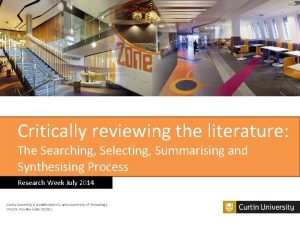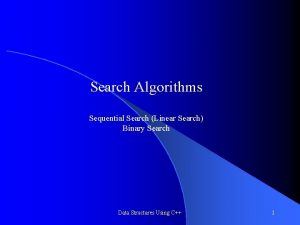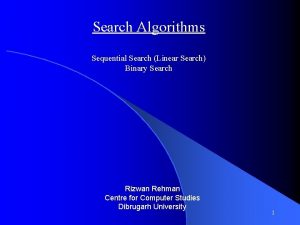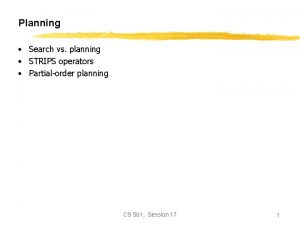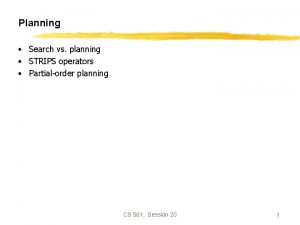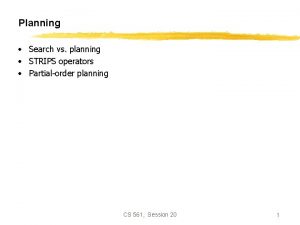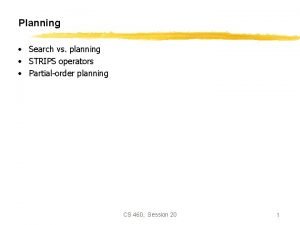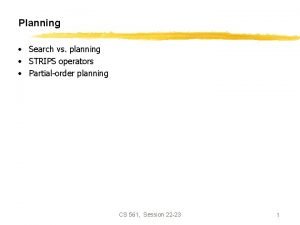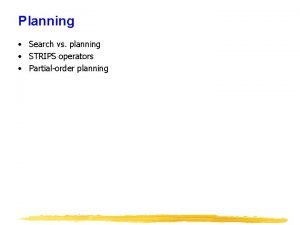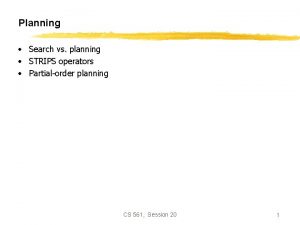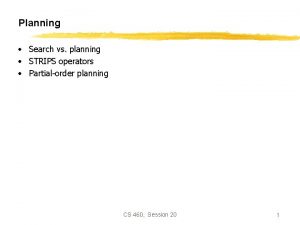Search Review Path Planning Search Our Role We







































- Slides: 39

Search Review

Path Planning Search: Our Role • We have to define the problem space – – – State Representation Initial State Operators Goal State (a test to see if a node is the goal) (If possible) A heuristic • We have to pick the right algorithm – We do not need to invent an algorithm – If you have a heuristic, no choice! Us A*

Which Algorithm to Use • Can you create an admissible heuristic? Then use A* (Rubik's Cube, 15 -puzzle, GPS routing finding, maze searching…) Otherwise • Do you know the exact depth of the solution? Then use depth limited search (frogs and toads) • Is the search tree finite, and you just want a solution (does not have to be optimal)? Then maybe use depth-first search. • Do you want the optimal solution, but don’t know how deep the solution could be? Try Iterative deepening. • Do you want the optimal solution, the goal state is explicit, you have a plan to detect repeated states, and you want the fastest possible results? Try bidirectional search (probably using Iterative deepening from both directions) (GPS route finding)

Three Possible Outcomes of Search • The algorithm finds the goal node, and reports success. • The algorithm keeps searching until there is nothing left in the queue, and then reports failure. (This failure can be seen as successfully proving that there is no solution) • The algorithm keeps searching until you run out of memory, or you run out of time and kill the program.

Diameter of a Search Problem I • The diameter of a search problem is the cost of the cheapest solution to the hardest problem in the search space. • If all operators have the same cost, it the just tree depth at which the cheapest goal state lies, for the worst instantiation of the problem. • Assume both of the below are the worse cases of two problems Diameter = 9 55 2 2 operators have the same cost 7 1 Diameter = 2 5 operators have the varying costs

Diameter of a Search Problem II • Sometimes we know the diameter of a search problem, because someone worked it out. • For example, for Rubik’s cube it is 20, for the 15 -puzzle it is 80, for the N Frogs and Toads problem, it is N 2 + 2 N etc • Let us practice stating some English sentences that capture this: – No matter how long John spends randomly scrambling a Rubik’s cube, an optimal algorithm can always solve it in 20 moves or less. – Susan created a new GPU-based algorithm to solve the Rubik’s cube. It was able to solve a scrambled cube in just 0. 000001 seconds, using 23 moves. The algorithm is fast, but clearly not optimal.

Diameter of a Search Problem III • Sometimes we don’t know the diameter of a search problem, the best we can do is provide a guess, or upper and/or lower bounds. • For example: – For the 24 -puzzle the diameter is unknown. But it is known to be at least 152 and at most 208. – For the GPS route finding problem in Ireland, the diameter is a little more than 300 miles.

Exercise: The 2 Cube Problem • Your friend takes two solved Rubik's cubes. • She scrambles each one for as long as she likes. • You task is to transform one to the other, in as few moves possible. • What can we say about the diameter of 2 Cube? ___ ≤ Diameter(2 Cube) ≤ ___ Your Task

Diameter of a Search Problem IIII • Why do we care about the Diameter? Part 1 • Assuming we also know the branching factor (even approximately), then knowing the diameter give us a worst case for the problem space. For example: – A problem with a BF of 10 and a diameter of 9 means we might have to search a billion nodes (109). If we can check 10, 000 nodes a second, that would take about a day. – A problem with a BF of 5 and a diameter of 20 means we might have to search about 95 trillion nodes (520). If we can check 10, 000 nodes a second, that would take about a 300 years. • This reasoning only applies to the worst case. It may be that most cases are much simpler. For example: – For the 15 puzzle, of the 10, 461, 394, 944, 000 solvable states, only 17 are at depth 80. Most puzzles take under 65 moves (see distribution). – For GPS directions, most journeys are 20 miles or less. http: //kociemba. org/fifteensolver. html

Diameter of a Search Problem V • Why do we care about the Diameter? Part 2 • Knowing the diameter immediately suggests two algorithms we might want to use. – Depth-limited search, with the depth set to the Diameter. (will be complete, but not optimal) – Iterative Deepening (will be complete, and optimal)

A* I • A* is optimal and complete. • For any given heuristic, A* is optimally fast. • There is no point trying to beat A*, but you may be able to find a better heuristic on a given problem. • Suppose there are two heuristics, h. A(n) and h. B(n). • It could be that one is always best, then you should only use the best one (how would you know this? ) • If sometimes h. A(n) is best, and other times h. B(n) best, then there is a simple trick you can do. Use h. C(n), where: h. C(n) = max[ h. A(n) , h. B(n) ]

A* II A heuristic is a function that, when applied to a state, returns a number tells us approximately how far the state is from the goal state*. – – How many miles to drive How many twists of the Rubik’s Cube How many tiles we have to slide. How many … Note we said “approximately”. Heuristics might underestimate or overestimate the merit of a state. But for reasons which we will see, heuristics that only underestimate are very desirable, and are called admissible.

The true driving distance from BCOE to Sub Station is 0. 6 miles. The straight line heuristic says it is 0. 269. This is an admissible heuristic

Why Greedy Search Fails Find Route from Dublin to Arklow Dublin Let us say that because the roads are pretty straight, the h(n) costs are basically the same as the true costs. 100 Wicklow 300 This just makes my example easier to explain, even if the h(n) estimates are lower than the true costs, my point is true. 120 60 Wexford Arklow

Greedy Search: Dequeue the cheapest node first. In other words, keep Nodes sorted by h(n), with cheapest node at the head of the queue.

Why Greedy Search Fails Find Route from Dublin to Arklow Dublin 100 Wexford Wicklow We expand the children of Dublin {Wexford, Wicklow } Greedy search asks “Which one of you thinks you are closest to Arklow? ” Wexford thinks it is only 60 miles, but Wicklow thinks it is 120 miles, so greedy search say “Lets expand Wexford” Wicklow 300 120 60 Wexford Arklow

Why Greedy Search Fails Find Route from Dublin to Arklow Dublin 300 Dublin 100 Wicklow Wexford Wicklow 300 60 Arklow Greedy search found the goal, it was 300 + 60 = 360 miles. Greedy search only looked at the h(n) costs, it only looked forward. 120 60 Wexford Arklow

Greedy Search Vs A-Star Find Route from Dublin to Arklow Dublin 300 Wexford Dublin 100 Wicklow We expand the children of Dublin {Wexford, Wicklow } A*search asks “Which one of you thinks you are closest to Arklow, after you add in the miles you have already traveled, your g(n) costs? ” Wexford says, I have gone 300, and have 60 miles to go. Wicklow says, I have gone 100, and have 120 miles to go. So A* search says “Lets expand Wicklow” Wicklow 300 120 60 Wexford Arklow

Greedy Search Vs A* Find Route from Dublin to Arklow Dublin 300 Wexford Dublin 100 Wicklow 300 120 Arklow Greedy search only looked at the h(n) costs, it only looked forward. But A-Star looked backwards and forward to make its decision. f(n) = g(n) + h(n) 120 60 Wexford Arklow

Romania

Romania

Romania


Romania Problem Initial state: Arad Goal state: Bucharest Operators: From any node, you can visit any connected node. Operator cost, the driving distnace. What is the BF for this problem?

We can use the straight line heuristic These are the h(n) values.

These are the g(n) values. These are the h(n) values.

Greedy best-first search example In other words, we are searching using only the h(n)

We expand all possible operators (there are three), and then expand the cheapest node on the fringe… 253 329 374

Now the cheapest node on the fringe is Fagaras, so we expand it

We are done! So, Arad to Sibiu to Fagaras to Bucharest 140 + 99 + 211 = 450 Is this optimal?

Properties of greedy best-first search • Complete? No – can get stuck in loops, e. g. , • Iasi Neamt… • But, complete in finite space with repeated state checking! (may take a lot of memory) • Time? O(bm), but a good heuristic can give dramatic improvement Similar to depth-first search • Space? O(bm) -- keeps all nodes in memory • Optimal? No!

A* Search Intuition: Greedy best-first search expands the node that appears to have shortest path to goal (looks only forward). But what about cost of getting to that node? Take it into account (also look backwards)! • Idea: avoid expanding paths that are already relatively expensive • Evaluation function f(n) = g(n) + h(n) – g(n) = cost so far to reach n – h(n) = estimated cost from n to goal – f(n) = estimated total cost of path through n to goal Aside: do we still have “looping problem”? Iasi to Fagaras: Iasi Neamt… No! We’ll eventually get out of it, because g(n) keeps going up.

A* search example In other words, we are searching using the sum of h(n) and g(n) f(n) = h(n) and g(n)




Bucharest appears on the fringe but not selected for expansion since its cost (450) is higher than that of Pitesti (417).

A* found: Arad to Sibiu to Rimnicu to Pitesti to Bucharest = 418 miles Greedy Search found: Arad to Sibiu to Fagaras to Bucharest = 450 miles A* found the optimal path!

Blind Search The search techniques we have seen so far. . . • Breadth first search • Uniform cost search • Depth first search • Depth limited search • Iterative Deepening • Bi-directional Search Would also find the optimal solution, but would have expanded more nodes (memory problems) Will not find optimal solution (in general) Would also find the optimal solution, but would have expanded more nodes (no memory problems, but time problems) Would also find the optimal solution, assuming both algorithms used would have found the optimal solution
 Unity iot
Unity iot Principle of art
Principle of art Azure worker role
Azure worker role Interaktionistisches rollenmodell
Interaktionistisches rollenmodell Role conflict occurs when fulfilling the role expectations
Role conflict occurs when fulfilling the role expectations What role should consumerism play in our economy?
What role should consumerism play in our economy? Importance of information technology in daily life
Importance of information technology in daily life The role of tv in our life
The role of tv in our life What role does nature play in our lives
What role does nature play in our lives What role should consumerism play in our economy
What role should consumerism play in our economy Role of grandparents
Role of grandparents Thinking affects our language, which then affects our:
Thinking affects our language, which then affects our: Our census our future
Our census our future Christ, be our light shine in our hearts
Christ, be our light shine in our hearts Our life is what our thoughts make it
Our life is what our thoughts make it We bow our hearts
We bow our hearts Our census our future
Our census our future Our life is what our thoughts make it
Our life is what our thoughts make it Money madness poem text
Money madness poem text Awareness of ourselves and our environment is:
Awareness of ourselves and our environment is: Awareness of ourselves and our environment
Awareness of ourselves and our environment God our father christ our brother
God our father christ our brother Our future is in our hands quotes
Our future is in our hands quotes Our awareness of ourselves and our environment.
Our awareness of ourselves and our environment. Our awareness of ourselves and our environment
Our awareness of ourselves and our environment Strategic planning career path
Strategic planning career path Role of literature review in research
Role of literature review in research Our own english high school boys branch sharjah
Our own english high school boys branch sharjah Role of sourcing in supply chain
Role of sourcing in supply chain Role of nurse in family welfare programme
Role of nurse in family welfare programme Role of aggregate planning
Role of aggregate planning Aperture concept in media planning
Aperture concept in media planning Role segmentation workforce planning
Role segmentation workforce planning Scenario planning workforce planning
Scenario planning workforce planning Corporate strategy
Corporate strategy Chapter review motion part a vocabulary review answer key
Chapter review motion part a vocabulary review answer key Writ of certiorari ap gov example
Writ of certiorari ap gov example Nader amin-salehi
Nader amin-salehi Prisma diagram example
Prisma diagram example Narrative review vs systematic review
Narrative review vs systematic review


























